
General John Charles Meyer was an American World War II flying ace, and later the commander-in-chief of the Strategic Air Command (SAC) and director of the Joint Strategic Target Planning Staff at Offutt Air Force Base, Nebraska. SAC was the United States' major nuclear deterrent force with bombers, tankers and reconnaissance aircraft, and intercontinental ballistic missiles. The Joint Strategic Target Planning Staff coordinated the nation's nuclear war plans and developed the Single Integrated Operations Plan.
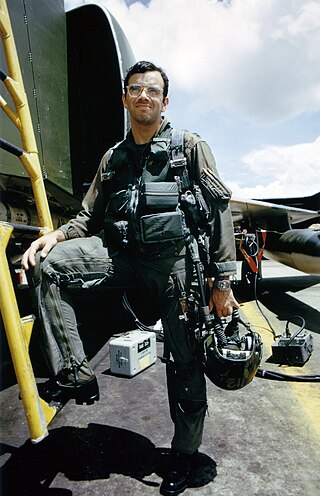
Jeffrey S. Feinstein is a retired career officer of the United States Air Force (USAF). During the Vietnam War, Feinstein was a weapon systems officer, an integral part of two-man aircrews with the emergence of air-to-air missiles as the primary weapons during aerial combat. Flying aboard F-4 Phantom IIs, Feinstein downed five enemy aircraft, thereby becoming a flying ace, the last of five U.S. aviators to become aces during that conflict and to date still the most recent aviator to achieve ace status in the U.S. military.

The 357th Fighter Group was an air combat unit of the United States Army Air Forces during the Second World War. The 357th operated P-51 Mustang aircraft as part of the U.S. Eighth Air Force and its members were known unofficially as the Yoxford Boys after the village of Yoxford near their base in the UK. Its victory totals in air-to-air combat are the most of any P-51 group in the Eighth Air Force and third among all groups fighting in Europe.

Jay Thorpe Robbins was a career officer in the United States Air Force who rose to the rank of lieutenant general. He was also a United States Army Air Forces fighter ace of World War II.

The 359th Fighter Group was a United States Army Air Force fighter unit that was active during World War II. Following organization and training in the United States, the group deployed to the European Theater of Operations, operating from RAF East Wretham. The fighter group flew 346 combat missions over continental Europe and claimed 373 enemy aircraft in aerial combat and strafing attacks; probable destruction of 23; and damage to 185. It was awarded the Distinguished Unit Citation for its actions. The group flew its last mission on 20 April 1945, then returned to the United States for inactivation.

Lieutenant General Winton Whittier Marshall was a United States Air Force general and flying ace. He was deputy commander in chief, U.S. Readiness Command, with headquarters at MacDill Air Force Base in Florida before retiring in 1977.

William Thomas Whisner Jr. was a career officer and pilot in the United States Air Force, retiring as a colonel with 30 years of military service. He was a fighter ace with Army Air Forces over Europe in World War II and a jet fighter ace with the Air Force in the Korean War.

Cuthbert Augustus "Bill" Pattillo was a major general in the United States Air Force who served as director of plans and policy for the United States Readiness Command at MacDill Air Force Base. Patillo was well known in the aviation community as a pioneer in jet aerobatic demonstration teams and was highly decorated as a fighter pilot, serving in World War II and the Vietnam War, and was a founding member of the Thunderbirds, the US Air Force Air Demonstration Squadron.

Gerald Richard Johnson was a World War II flying ace who flew for the United States Army Air Forces. Johnson commanded the 9th Fighter Squadron and 49th Fighter Group, and became the fourth ranking fighter ace in the Pacific during World War II. He ended his war career with 22 kills.

Glenn Todd Eagleston was a career officer in the United States Air Force and the leading ace of Ninth Air Force in Europe in World War II. Eagleston was credited with 18 1/2 victories, two probable victories, and seven damaged German aircraft. He also destroyed at least five enemy aircraft on the ground, while flying P-51 Mustangs with the 354th Fighter Group.

Paul Page Douglas Jr was a brigadier general in the United States Air Force. During World War II, he flew the P-47 Thunderbolt in the European Theater of Operations and became one of the most highly decorated flying aces of the war. In 1968, he served as the commander of the 388th Tactical Fighter Wing and flew a full tour of bombing and fighter missions over North Vietnam. He retired from the Air Force on 1970.

Robert Ray Scott was a career officer in the United States Air Force, who flew combat missions in World War II, Korean War and Vietnam War.

William Douglas Dunham was an American flying ace in the 348th Fighter Group during World War II, scoring 16 aerial victories. He retired from the United States Air Force in 1970 at the rank of brigadier general.
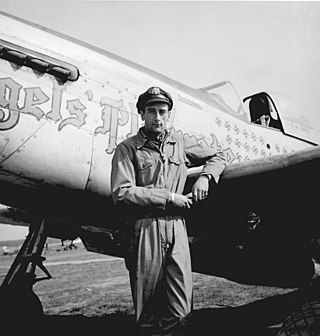
Bruce Ward Carr was a highly decorated United States Air Force colonel. During World War II, he was shot down over Germany and, after evading capture for several days, snuck into a Luftwaffe airfield and stole an enemy plane which he flew back to Allied lines. He also became a flying ace credited with 14 or 15 aerial victories, including five in a single day, for which he was awarded the Distinguished Service Cross.
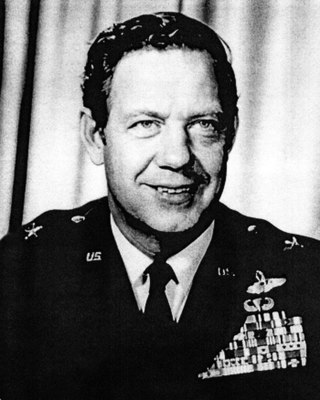
Robert F. Titus was a brigadier general and a career fighter pilot in the United States Air Force. Titus flew a combined total of 500 combat missions in Korean War and Vietnam War, and was credited in destroying 3 enemy aircraft in aerial combat during the Vietnam War.
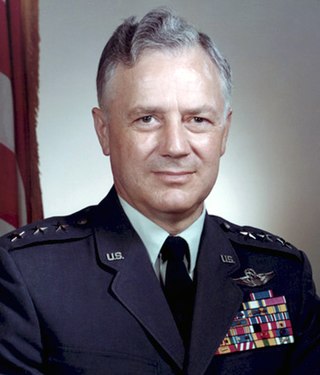
Donavon Francis Smith was a United States Army Air Forces flying ace during the World War II. He accrued 5.5 victories in the war.

Joseph John Kruzel was a United States Air Force major general and a flying ace during World War II.

Edwin Lewis Heller was a United States Air Force lieutenant colonel and a flying ace, who was credited in destroying 5.5 enemy aircraft in aerial combat and 14 enemy aircraft on the ground during World War II. He also served in the Korean War, where he was credited in destroying 3.5 enemy aircraft before he was subsequently shot down and taken prisoner.

Frank Lewis Gailer Jr. was an American flying ace in the 357th Fighter Group during World War II, and a career fighter pilot in the United States Air Force. During World War II, Gailer was credited in the destruction of 5.5 enemy aircraft in aerial combat before he was subsequently shot down and taken prisoner. During Vietnam War, he commanded a fighter wing and flew more than 200 combat missions.
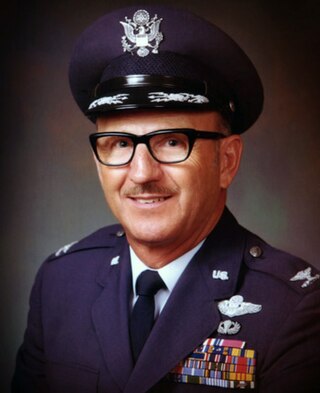
Virgil Kersh Meroney II was a United States Air Force colonel. During World War II, he became a flying ace credited with nine aerial victories while flying the P-47 Thunderbolt, making him the only P-47 ace in the 352nd Fighter Group. He himself was shot down and captured as a prisoner of war before his successful escape from captivity. He also flew missions during the Korean War and Vietnam War before he retired from the air force in 1970.

























